DR650 HID Headlight Conversion
The “Bikemaster” brand HID headlight kit is available in several different bulb types.
We installed the H4 kit on the Suzuki DR650 (blog) but the steps are the same for every bike.
The HID bulb posed no difficulties; it is a direct replacement for the H4.
Locating a suitable mounting position for the ballast is a bit difficult, depending on the bike.
The new HID headlight is definitely “whiter” than the standard halogen bulb, but the pattern doesn’t seem quite as good.
Other than the color, there doesn’t seem to be much difference in light output. Thus, it’s an interesting accessory but probably not worth the effort on this particular bike.
Always on the lookout for new and better motorcycle accessories — especially when it comes to lighting — we purchased a Bikemaster brand HID headlight upgrade kit for the DR650.
Actually, there isn’t much wrong with the stock headlight on the DR650; it puts out a nice pattern with adequate light.
And when it’s combined with the night-into-day power of the Clearwater Krista LED lights (review), there’s basically nothing that can beat it.
That a “small” bike like the DR650 can place so many lumens at your disposal is a testament to modern science, that’s for sure!
But, to get that very last photon of lighting power, we figured an HID headlight upgrade would be the way to go.
Fortunately, there are now many HID headlight kits that are relatively inexpensive and readily available. Installing one is more-or-less a plug-and-play operation that just about any owner can accomplish.
The Bikemaster HID headlight upgrade kits are probably the most common and they have a pretty good reputation, so let’s take a look at a typical installation that should be similar for just about any motorcycle.
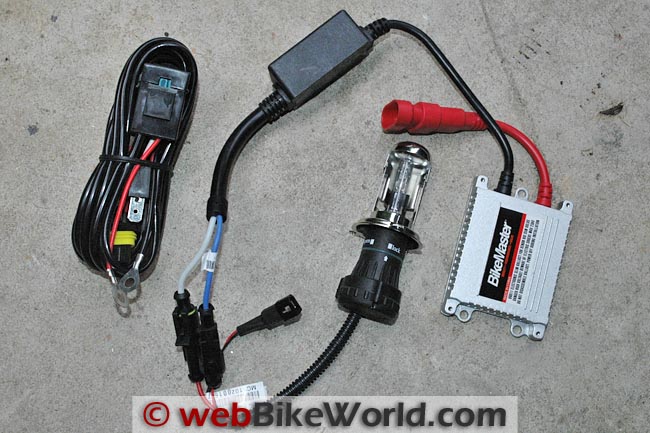
Where to Buy HID Headlight Conversion
Check Reviews & Prices on AmazonAlso Shop for: LED Lights and Bulbs, Auxiliary Driving Lights, Motorcycle LED Headlights
The Bikemaster Motorcycle HID Headlight Upgrade Kit
“Back in the old days” (not all that long ago actually), HID motorcycle headlights were a novelty. Installing one was sometimes a shot in the dark, if you’ll pardon the pun.
You can basically learn the history of motorcycle HID headlight upgrades in the various reviews published on webBikeWorld during the last decade.
- Those include Dr. Mike’s “Installing an HID Motorcycle Headlight” on a BMW K1200LT.
- Pete Van Dyke’s “Installing an HID Motorcycle Headlight” using the Xenon Depot 4300K kit.
- And the background information on HID Headlight Upgrades that pretty much tells it all from a 2005 point of view.
In fact, that 2005 story sums up the issues and problems in installing an HID headlight back then.
An owner had to choose a headlight (including the headlight shell and reflector), then a ballast, and somehow fettle everything together without burning up the bike, burning down the garage and without getting electrocuted in the process.
Which brings us to today.
All-in-one motorcycle HID headlight kits are now readily available, although some of the off-brand products are suspect.
Bikemaster isn’t one of them; the company is a well-known manufacturer of various motorcycle accessories, including LED lights and other electrical gizmos.
Their HID headlight replacement kits are compact, complete and well made.
This is an established brand, not one of those fly-by-night operators on that famous (infamous) used-to-be-an-auction-website everyone loves to hate…
The Bikemaster HID headlight kit is available with an H4 low/high beam, along with H7, H9, H11, H13 and 9005 type single-beam bulb replacements, so there should be one for just about every motorcycle out there.
The Suzuki DR650 has a basic old-school square headlight with a stock H4 55/60W halogen bulb, so we bought the Bikemaster H4 HID kit.
Note that some motorcycles may have separate and different headlight bulbs for low beam and high beam, which would require two HID kits, one for each bulb.
This would probably cause quite a bit of added complication in mounting both ballasts (or the owner could use either a low beam or high beam HID replacement only if desired).
The list price is $79.95 but the Bikemaster Motorcycle HID light kits can be had for as little as $52.36 through that webBikeWorld affiliate link. The H4 kit shown here cost $58.83.
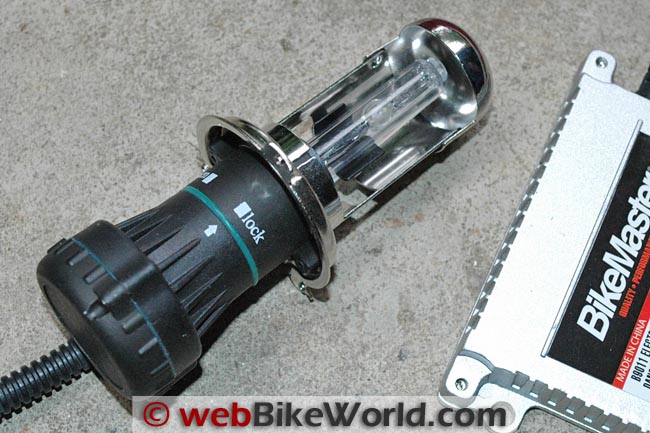
The HID Bulb
The Bikemaster kit comes with your choice of bulb type.
The H4 bulb has a sliding cover that changes the focus from low beam to high beam and we assume the other bulb types do the same.
This is different from “the old days”, when HID bulbs operated either on low beam or high beam but not always both.
The Bikemaster electronics switch the bulb from low to high beam just like the stock halogen incandescent bulb — one less engineering issue for the owner to solve. Replacement bulbs are also available for the Bikemaster system.
There isn’t a lot of information about the kit on the Bikemaster website, but some retailers claim that the HID bulb takes 35 Watts, compared to 55/60W for the stock bulb.
So this saves a few of those scarce DR650 electrons for other electronic goodies. The manufacturer makes no claim as to the actual output of the bulb.
By the way, if you’re looking for more power for your DR650, be sure to read our report on the DR650 250 Watt stator upgrade, which provides more power to the bike’s electrical system.
The H4 HID bulb replacement slips into the existing socket on the DR650 and then the three-prong connector from the Bikemaster kit replaces the stock unit.
As is the case with any headlight (or tail light) bulb, do not touch it, because the oil from your skin can cause hot spots on the bulb. If you do touch it, clean it with alcohol first.
The rubber bulb cover on our DR650 had been damaged by the previous owner, so it didn’t quite fit over the wider base of the Bikemaster H4 HID bulb and we had to use a cable tie to secure it (photo below).
The instructions state that the base mount of the H4 HID bulb type can be adjusted to fit different headlights, although we did not adjust ours.
Note that the HID light pattern can vary quite a bit, depending on the design of the reflector on your particular motorcycle.
We found that the HID light accurately replicates the standard pattern on this bike, which is the minimum requirement.
In other words, you don’t want to end up with a light pattern that is worse than what you have from the stock light.
Also, the Bikemaster HID headlight kits are available in different light “temperatures”. This kit is the 6000K (Kelvin) kit, which has a “white” light, roughly equivalent to the color of sunlight at noon.
An 8000K Bikemaster HID headlight kit is also available; the 8000K bulb has a “blue” light that can be annoying.
The 6000K HID bulb color matches both the Clearwater Krista LED lights (review) and the BikeVis Bullets (review) we have installed on the DR650 for a nice, even look when all the lights are on.
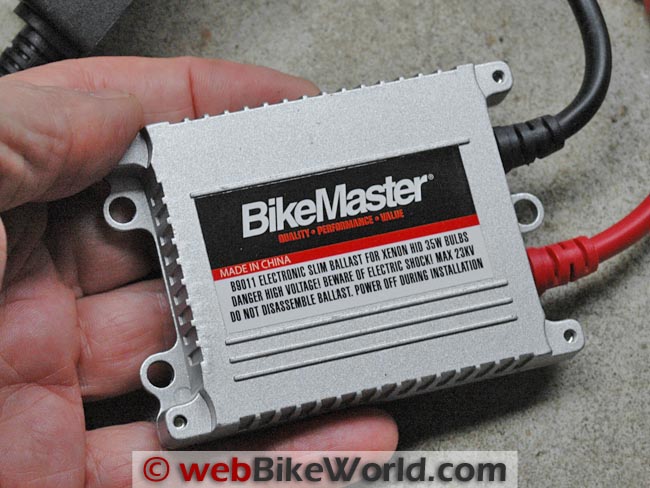
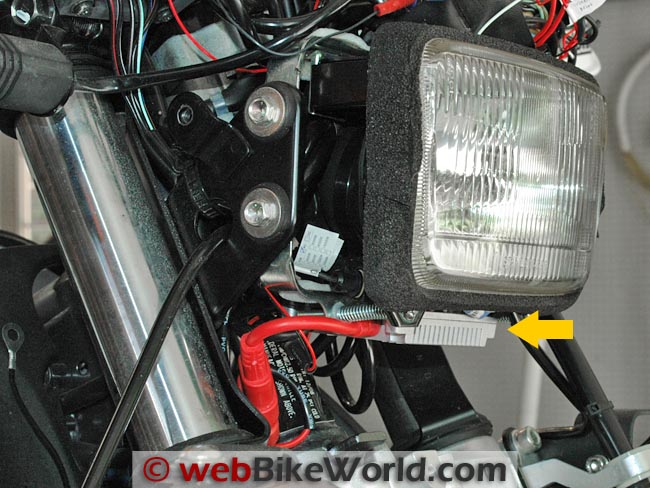
Where to Buy HID Headlight Conversion
Check Reviews & Prices on AmazonAlso Shop for: LED Lights and Bulbs, Auxiliary Driving Lights, Motorcycle LED Headlights
The HID Ballast
The kit comes with an attached ballast, which regulates the power output to the HID bulb.
There is a warning in the instructions that states that the ballast can store up to 23,000 Volts of juice, so you definitely want to make sure the power is off and the battery is disconnected before starting this installation.
The high power is used for the igniter that fires up the HID bulb at first to get the arc going. Once it’s up, the bike’s electrical system takes over.
This is why it’s important not to start and stop the bike quickly with an HID bulb installed.
Once the bike is started, it should really be left running for 5 minutes or so to make sure the HID light is powered up. Starting and stopping the light can shorten the lifespan of the HID bulb.
If you really want some technical info on how an HID ballast works, read this technical paper (.pdf) entitled Analysis and Design of High-Intensity-Discharge Lamp Ballast for Automotive Headlampby Yongxuan Hu (Virginia Polytechnic Institute and State University).
The Bikemaster HID kit ballast is relatively small, compared to some other brands (and especially compared to the ballasts of 10 years ago). It must be mounted separately somewhere on the bike.
Note also that each ballast is designed specifically for the particular bulb and kit, so it’s not a good idea to replace the ballast with a different brand.
There isn’t much room in the headlight assembly on the DR650 for mounting the ballast, but we fitted it under the headlight, attached to the square metal headlight bracket.
The ballast has three mounting holes, so it can be mounted under the headlight or inside a fairing on a bike so equipped.
Finding a location for and mounting the ballast is the most difficult part of the installation actually; everything else is plug-and-play.
The wiring harness is then connected directly to the motorcycle battery for power.
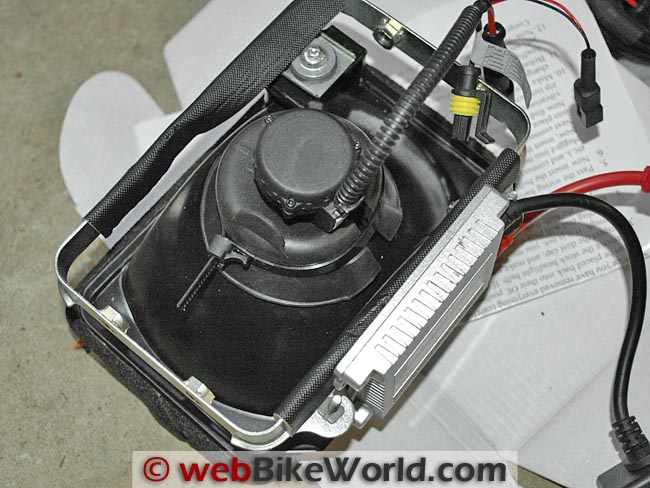
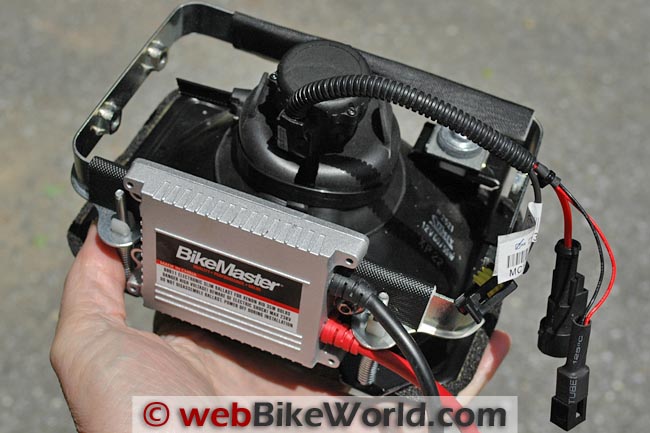
The Results
We weren’t sure what to expect after installing the HID headlight kit, although we were anticipating more light.
It’s very difficult to get an accurate photograph of the lighting differences, and a couple of nights passed during the installation, which accounts for some of the differences in the photos.
But there doesn’t seem to be much of a difference between the HID light and the stock headlight on the DR650.
In fact, we might say that the HID headlight puts out less light than the stock bulb, although the pattern is roughly the same. This holds true when riding at night also; there just isn’t all that much difference between the two.
We wonder if any differences reported by owners are due to the light color, rather than any increased light output.
Also, the HID bulb doesn’t quite seem to cope with the DR650 headlight reflector and lens pattern as well as the stock bulb. The cutoff on low beam isn’t as defined with the HID bulb as it was with the stock bulb and we noticed this right away when riding at night.
The high beam pattern is nearly identical, however. This may be due to the arrangement of the HID bulb cover when switching from low to high beam.
These photos are an illustration. The light from the HID bulb is “whiter”, and the pattern is roughly the same. The first set of photos (stock bulb) was taken at f6.3, ISO800 with a 35.0 mm focal length.
The second set was the same except the focal length was slightly wider at 31.0 mm.
Low Beam Comparison

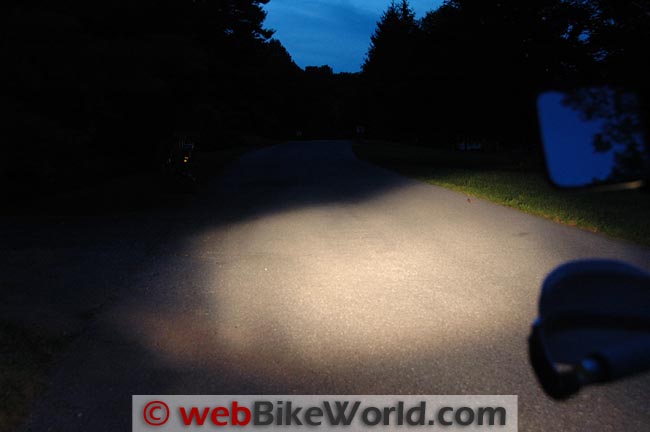
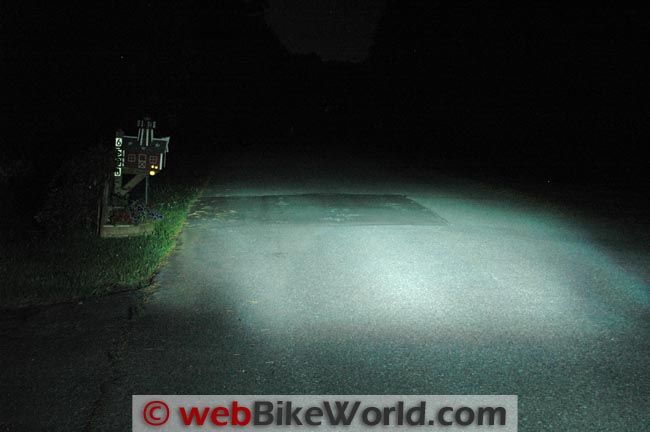
Where to Buy HID Headlight Conversion
Check Reviews & Prices on AmazonAlso Shop for: LED Lights and Bulbs, Auxiliary Driving Lights, Motorcycle LED Headlights
High Beam Comparison
Here are some photos illustrating the difference between the stock Suzuki DR650 high beam and the HID headlight conversion kit.

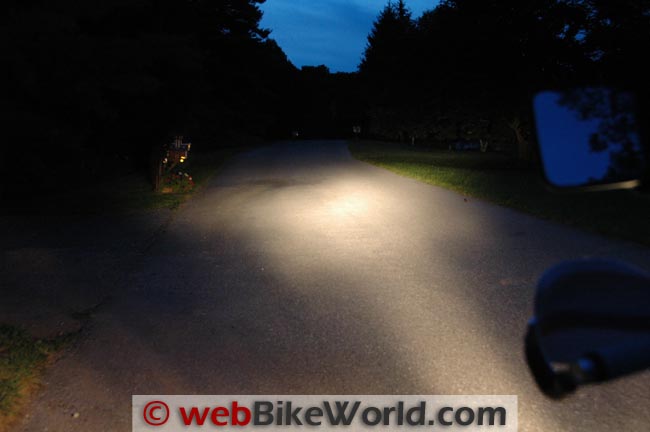
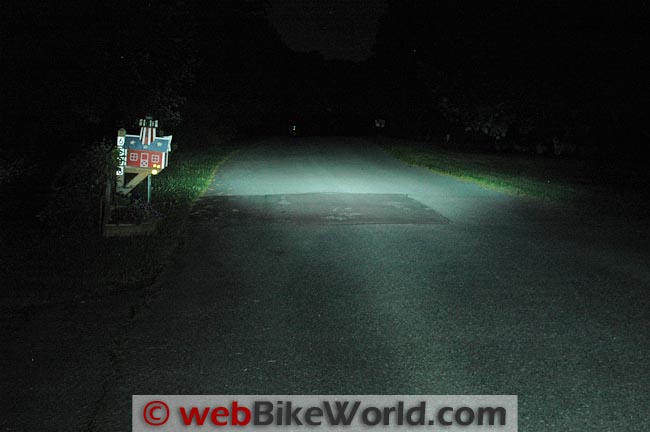
Conclusion
The Bikemaster HID headlight conversion kit is relatively easy to install — especially compared to HID systems from several years ago.
But the difference in light output just isn’t all that noticeable to us and this may be specific to the DR650 H4 kit, due to the reflector and lens assembly.
There is usually a compromise when installing an upgraded headlight bulb in a stock headlight shell; if the HID system was designed from scratch at the factory, the lens and reflector would be optimized to take advantage of the HID or Xenon bulb.
Your results may vary from worse to better. In this case, the HID kit wasn’t very expensive, so there’s not much lost. Would we do it again? Probably not.
The stock DR650 headlight is actually pretty good, all things considered.
Using a stock bulb also has some advantages; for example, if the bulb dies while you’re out in the boonies, it’s fairly easy to find or carry an H4 replacement.
Where to Buy HID Headlight Conversion
Check Reviews & Prices on AmazonAlso Shop for: LED Lights and Bulbs, Auxiliary Driving Lights, Motorcycle LED Headlights
Owner Comments and Feedback
See details on submitting comments.
From “N.A.” (February 2015): “I installed the Bikemaster brand HID headlight about 30 days ago. Never could get the high/low beam adjusted to where it is suppose to throw the light.
To get the low beam to point even close to where it was suppose to, had to screw in the adjustments till they were just about all the way in.
Headlight looked like it was pointing right a the front of the front fender as it was pointing so low. Even then the beam was just about horizontal with road. Forget the high beam, it was like a searchlight looking for bombers.
I checked the seating of the bulb. It was not hitting anything to cause it to not be aligned.
Procycle states on their web site that the bulb only draws 35 watts. That’s the catch, the bulb may only draw that, but add the ballast then how much?
Not until I received the package was there any warning of not being able to get a proper adjustment because of the variations in headlight reflector. Not only that, but the instruction stated must use a 20 amp fuse…
So that in itself is clearly stating that the setup draw a lot more than 35 watts.
Took it off, listed the whole kit as a freebee give away and no one wants it. I put it in the trash this coming Thursday.”
Editor’s Note: No problems at all to report on ours, it works fine and as you can see in the photos above, the high and low beam adjusts correctly via the handlebar high/low beam switch.
But the stock DR650 headlight is pretty good also so there may not be much of a reason to install an HID headlight. Are you sure you purchased the correct kit for your bike and that it was installed correctly?
The ballast converts DC to AC and needs a larger-size fuse because it takes a lot of juice to get the HID arc going at first.
More info on the HID ballast in this discussion. Here’s an excerpt:
“The modern electronic ballast used for HID lights (which are essentially metal halide gas-discharge lamps) is a DC to AC inverter with a current-limited or sometimes regulated output.
There is also a circuit called a “striker” which is usually integrated into the ballast module. The striker generates a train of very high voltage (2-5kV) pulses which cause the gas inside the lamp to break down and ionize.
Once the gas ionizes, it will conduct electrical current at a much lower voltage, and then the high frequency AC output of the inverter continues to keep it ionized and in operation.
In this mode, the voltage present across the lamp’s terminals may be anywhere between 70-300V, depending on the lamp and application.”
Also from this .pdf document explaining the purpose of the ballast:
“An arc–discharge lamp initially starts as a non–conductive gas between two electrodes. The ballast must supply adequate voltage to initiate an arc between the electrodes.
This voltage is supplied by a transformer section within the ballast, and is sometimes supplemented by an igniter that supplies additional high voltage pulses timed with the peak of the transformer voltage.
Once the gas in the lamp’s arc tube becomes ionized, the electrical resistance drops very low. The ballast must then limit the current to protect the electrodes from overheating.
As the current flows through the ionized arc stream, the gas is heated and pressure builds within the arc tube. This pressure in turn causes resistance to develop in the arc stream.
The increased resistance leads to further heating and pressure. The ballast must control the current to make the lamp operate in a stable manner at its proper wattage.
Without current regulation of the ballast, the pressure would increase until the voltage supplied to the lamp is incapable of passing between the electrodes.
The ionization would cease and the lamp extinguish. Improper ballasting will cause lamps to operate outside their optimum performance envelope.
The result is that lamps won’t operate at their correct wattage, won’t produce the correct light output, and will experience shortened life.
The ballast must therefore supply proper voltage to start and maintain the arc, and must control current to regulate the lamp at its correct operating wattage.
From “P.Y.” (September 2012): “There are no legal HID conversion kits in the US. The DOT has no testing apparatus or requirements (like the TUV in Germany), so there also is no such thing as DOT approved.
If you see it it’s just marketing BS.
There are some tests that the government has published on HID conversions and they fail miserably in meeting federal standards.
One of the problems you had is very typical, the HID arc is in the wrong place in relation to the reflector so it can not put the light where it needs to be.
People will argue about how much more light they have in front of them, but don’t realize how much of that light is going into the eyes of oncoming traffic.
There are some areas of the country where law enforcement is very aggressive about improper lighting, but most places it doesn’t seem to be a big deal. HIDs kits generally are very easy to spot because most have very high levels of glare.
If you look at the headlights of a high end car coming at you all you see are two pinpoints of light that are not intrusive. If the light from your kit doesn’t have a sharp cutoff and has stray light in odd places, it doesn’t work!
There is really only one way to do it properly and that is with a conversion to a projector headlight that is designed as an HID.
Editor’s Reply: Just for the record, we never said the kit met any type of U.S. DOT or other lighting standards.
I’d guess one of the reasons why the Bikemaster HID unit puts out almost an identical amount of light and in the same pattern is to try and make it as “legal” as possible.
Also, there have been many improvements in the design of HID kits over the years, as was implied in the article, so the design and placement of the bulb is more accurate than it was in the past, which for the most part helps to eliminate the glare issue with oncoming traffic.
In the end, the only thing the Bikemaster HID kit did was possibly lower the power requirement for the bike and give a “whiter” light.
The amount of light and the pattern is nearly identical to the stock incandescent bulb on this bike.
From “P.W.” (September 2012): “Contrary to the stated assumption in the review, all of the other listed bulb types are single output only with no sliding cover.
The internal setup on a H-4 HID makes up for the fact that it lacks the two filaments found in an H-4 halogen. All the other types listed are single filament types as halogens so don’t need such mechanisms.
They might perform better than your H-4 version for that reason alone but only testing such a kit would answer that.
The lower than expected out indicates a problem of some sort with this individual kit or possibly the design. A 35W HID is typically 3200 lumens while a 55W halogen is typically only 1400-1500 lumens, a big difference.
The low output might be caused by bad ballast design, a bulb with low output or an output robbing coating (common on Asian cheapie HID) or something else.
Generally the OEM 4100-4300K HID lamps have the most output.
In any case, the human eye is most sensitive at more yellow wavelengths so when you go “whiter” (more blue wavelengths) it takes a bit more reflecting back at you to register as the same output level the way your eye detects it.
Its true that the running HID bulb is probably consuming the 35W output of the ballast. But for HID systems it is the ballast that determines how much wattage is used and no ballast is 100% efficient.
This is unlike a halogen setup where the bulb is the current determining device.
There is also a significant extra startup demand for HIDs. Probably the ballast is consuming low 40 Watts while in operation and not much less than a regular halogen on startup.
Either direct measurement or the maker can provide the exact numbers.”
Editor’s Reply: Actually, the article does state (in “The Bikemaster Motorcycle HID Headlight Upgrade Kit” section) that the other bulbs are single beam and the owner might need two HID units for high and low beam, complicating the installation.
I went back to check and then also added more info in the paragraph before that to make this more clear.
Output varies depending on quality of the bulb, ballast, electronics, etc. but the biggest factor is the design of the reflector and lens.
The bulb, reflector and lens should really be engineered and designed as a unit to take advantage of a particular bulb type.
This is the same problem we have experienced with LED turn signals and brake lights; most don’t work as efficiently with stock reflector and lens assemblies, which aren’t designed to take advantage or to exploit the characteristics of the LED.
So the bulb may indeed have the correct output (although the manufacturer makes no claims for lumens or output) and it could be (probably is) the DR650 system that isn’t as efficient as it could be for an HID bulb.
But this is exactly the purpose of the article, to install the upgrade and let readers know that, at least for this particular bike, the upgrade may not make much of a difference.
Also, in most of the photos I’ve seen of Bikemaster HID light upgrades, the before/after differences appear to be minimal.
The conclusion is that if you really want more light, you’re probably better off buying auxiliary driving lights rather than messing with an HID bulb replacement, which may or may not work efficiently with the stock headlight unit.
From “K.Y.L.” (September 2012): “Do the HID conversions use less power for the same equivalent amount of light?
Most are more power efficient than the old-school incandescent bulb.
This would seemingly free up power for other things. supplemental LED lights, heating elements, the 6 disc CD changer and subwoofer…(joking.. 😀 ).
That seems quite worth it, if it is shaving 10% (5.5~6W) off the overall power draw in comparison to the H4 incandescent bulb (55~60W).”
Editor’s Reply: Yes, the manufacturer claims it takes only 35 Watts to run the HID bulb, compared to 55/60W for an incandescent stock bulb.
The HID arc remains the same (output) for low and high beam, just the shield moves over the arc to change the focus of the beam from low to high.
From “I.B.” (September 2012): “Just an FYI. Not sure about North America, but in EU states the conversion of a OEM headlight to HID can be illegal both for cars and motorcycles. Different states look upon them with varying degrees of punishment.
Two friends of mine travelling through Austria were recently fined €200 each for HID spotlights.”
Editor’s Note: Technically, probably the same in the U.S. but you can usually get away with it unless the lights are obnoxious. Local law enforcement probably would not know whether or not the headlight was original equipment.
The Bikemaster HID light has nearly the same output and pattern as the original, so it shouldn’t be an issue.
Other WebBikeWorld Motorcycle Lighting



No Comment